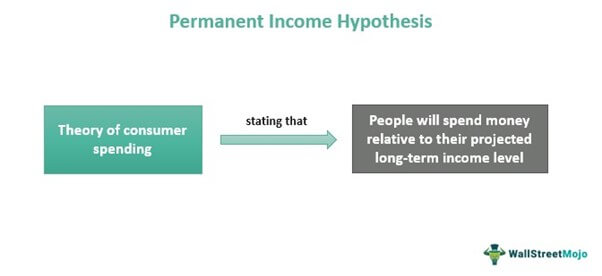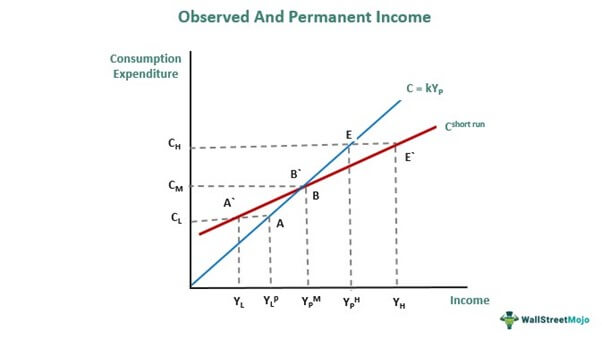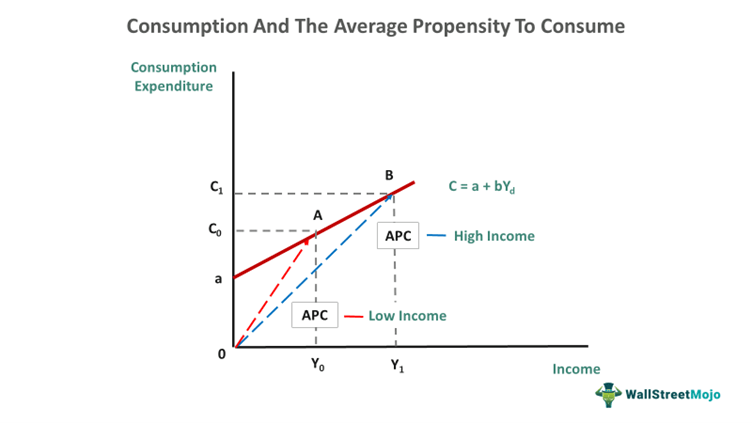What Is Permanent Income Hypothesis?
The Permanent income hypothesis (PIH) states that individuals will spend money at a level relative to their estimated long-term earnings. Consumers view a specific level of income as permanent or recurring. The theory implies that one cannot predict variations in consumer behavior as such changes occur due to individual expectations.

You are free to use this image on your website, templates, etc, Please provide us with an attribution linkHow to Provide Attribution?Article Link to be Hyperlinked
For eg:
Source: Permanent Income Hypothesis (wallstreetmojo.com)
Per this theory, workers will save money only if their current income exceeds their estimated permanent income level to protect themselves against any future decline in earnings. Moreover, it suggests that even if economic policies manage to increase income in an economy, consumer spending will not increase until the workers change their expectations concerning future earnings.
Table of contents
Key Takeaways
- The permanent income hypothesis definition states that individuals’ spending remains consistent with their estimated long-term income. Per Milton Friedman, who developed this theory, consumers view a certain income level as their permanent income.
- Individuals’ liquidity influences their consumption expenditure and income management, per the permanent income hypothesis of consumption. Therefore, people not having an asset may already have the habit of spending money irrespective of their present or future income.
- The theory suggests that if any economic policy manages to increase consumers’ income level, their spending will not necessarily increase.
Permanent Income Hypothesis Explained
The permanent income hypothesis definition refers to the theory that states that consumers spend their earnings at a level in accord with their estimated future income over the long term. Individuals view this expected income level as their permanent income level, which they believe is safe to spend.
Milton Friedman developed this theory in n 1957. According to him, individual expectations influence consumer spending, and the expectations vary depending on how consumers view the factors that impact future income. Hence, any policy decision affecting consumers’ perception of their long-term income will increase their spending.
In addition, an individual’s future earnings expectations also depend on their liquidity. One who does not possess any asset may already have a habit of spending money regardless of their current or future earnings. That said, changes in permanent income can occur via incremental salary increases or the assumption of better long-term jobs with improved and sustainable pay. If workers’ expectations increase, they may spend more.
Financial Modeling & Valuation Courses Bundle (25+ Hours Video Series)
–>> If you want to learn Financial Modeling & Valuation professionally , then do check this Financial Modeling & Valuation Course Bundle (25+ hours of video tutorials with step by step McDonald’s Financial Model). Unlock the art of financial modeling and valuation with a comprehensive course covering McDonald’s forecast methodologies, advanced valuation techniques, and financial statements.
Graph
Friedman divided the current measured earnings or the actual income into two categories — transitory income (YT) and permanent income (YP). Hence, Y = YP + YT. The transitory component has an estimated value of 0, reflecting the assumption that future transitory losses offset the transitory gains over time.
As a result, observed income levels (Y) are equal to YP. Finally, according to PIH, consumption expenditure is proportional to YP, i.e., C = kYP, where ‘k’ is a constant representing the average propensity to consume or APC and marginal propensity to consume or MPC.

You are free to use this image on your website, templates, etc, Please provide us with an attribution linkHow to Provide Attribution?Article Link to be Hyperlinked
For eg:
Source: Permanent Income Hypothesis (wallstreetmojo.com)
The theory describes the consumption function (shown with the blue line) more precisely as a long-run consumption function in accord with the long-run behavior of consumers.
The transitory income for different earnings groups explains observed short-run results of consumer behavior. Specifically, the theory assumes the transitory income for groups of individuals with low income to be negative. This reflects the assumption that transitory losses are more than transitory gains for these groups. This means YT < 0 or YTL < YPL.
In the case of middle-income groups, the transitory income becomes 0 over time, such that permanent and observed income have the same value. This means YTM = 0 or YM = YPM.

You are free to use this image on your website, templates, etc, Please provide us with an attribution linkHow to Provide Attribution?Article Link to be Hyperlinked
For eg:
Source: Permanent Income Hypothesis (wallstreetmojo.com)
Lastly, in the case of high-income groups, the transitory gains are more than the transitory losses such that the value of transitory income is positive on average over time. This means YTH > 0 or YH >YPH.
As one can observe in the graph, developing a short-run consumption function (red line) is possible using this transitory component’s impact.
The permanent income hypothesis of consumption offers a framework to understand how households might react to the variations in earnings while making consumption expenditure decisions in the near term.
If individuals view the variations in income as transitory, the changes might not impact consumer spending. On the other hand, changes in earnings perceived to be permanent can significantly impact consumption expenditure immediately.
Example
Let us look at this permanent income hypothesis example to understand the concept better.
Suppose a worker named Gary expects to get a bonus at the end of the financial year. It might be reasonable to think that his spending before receiving the bonus might change in anticipation of the extra income. However, according to this theory, he may choose not to spend more solely because of the windfall income. Instead, he might want to increase his savings.
Criticism of Permanent Income Hypothesis
The criticism concerning the permanent income hypothesis in macroeconomics centers around the following two assumptions:
- APC is constant
- The MPC from transitory income is 0.
Economists like Irving B. Kravis criticized Friedman’s theory for its assumption of a constant APC. They maintain that households with low permanent income levels are under more pressure than households having higher permanent income levels. Theoretically, the APC of low-income households must exceed that of high-income households. Hence, Kravis claimed that APC decreases as permanent income rises.
Moreover, various economists have criticized the theory’s assumption that MPC from transitory income equals 0. This is because there’s a lot of evidence suggesting that MPC from transitory income is positive. Earlier, the studies involved analyzing the effect of windfall income. According to such studies, windfall income increased consumption.
In addition, per recent studies, the MPC from transitory income is even more than the previous studies. The new studies also suggest that MPC from transitory income is less than that from permanent income.
This theory is difficult to test from an empirical standpoint as measuring permanent consumption, and permanent income is difficult. As a result, the debate on this theory’s advantages continues.
Frequently Asked Questions (FAQs)
The permanent income hypothesis in macroeconomics assumes a constant APC. The theory also assumes zero MPC from transitory income.
In the case of the life-cycle hypothesis, the current consumption remains a function of the overall lifetime resources. However, strict proportionality will not be a feature of the relationship. On the other hand, in the case of PIH, permanent consumption or Cp remains a function of permanent income, not current income.
An American economist name Milton Friedman came up with the theory in 1957. The theory suggests that one cannot predict consumer behavior as it depends on individual expectations.
According to the absolute income hypothesis, current income is a stable function of current income. However, per PIH, consumption depends on permanent income, not absolute or relative income.
Recommended Articles
This has been a guide to What is Permanent Income Hypothesis and its meaning. Here, we explain it with a graph and an example with criticism. You may also find some useful articles here –


Leave a Reply